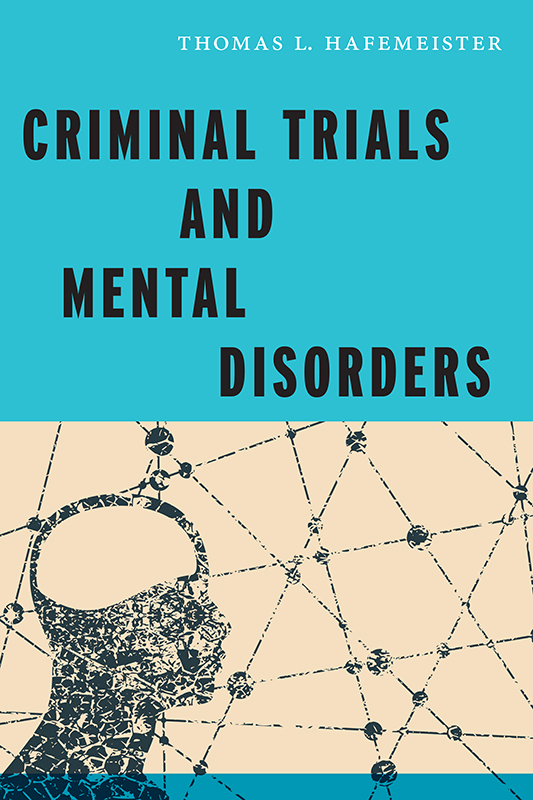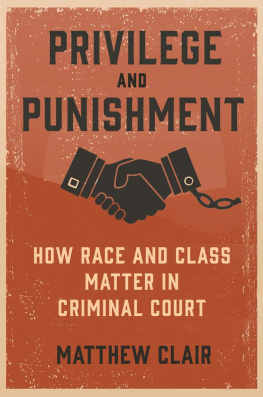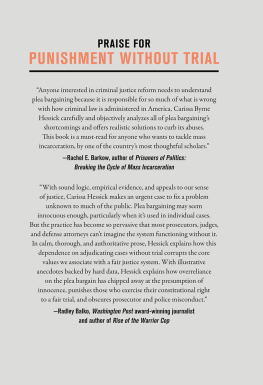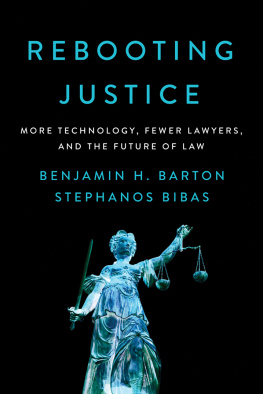
Criminal Trials and Mental Disorders
PSYCHOLOGY AND CRIME
General Editors: Brian Bornstein, University of Nebraska, and Monica Miller, University of Nevada, Reno
The Perversion of Youth: Controversies in the Assessment and Treatment of Juvenile Sex Offenders
Frank C. DiCataldo
Jury Decision Making: The State of the Science
Dennis J. Devine
Deviant and Criminal Behavior in the Workplace
Edited by Steven M. Elias
Psychopathy: An Introduction to Biological Findings and Their Implications
Andrea L. Glenn and Adrian Raine
Gender, Psychology, and Justice: The Mental Health of Women and Girls in the Legal System
Edited by Corinne C. Datchi and Julie R. Ancis
Criminal Trials and Mental Disorders
Thomas L. Hafemeister
Criminal Trials and Mental Disorders
Thomas L. Hafemeister

NEW YORK UNIVERSITY PRESS
New York
NEW YORK UNIVERSITY PRESS
New York
www.nyupress.org
2019 by New York University
All rights reserved
References to Internet websites (URLs) were accurate at the time of writing. Neither the author nor New York University Press is responsible for URLs that may have expired or changed since the manuscript was prepared.
Library of Congress Cataloging-in-Publication Data
Names: Hafemeister, Thomas L., author.
Title: Criminal trials and mental disorders / Thomas L. Hafemeister.
Description: New York : New York University Press, 2019. | Series: Psychology and crime | Includes bibliographical references and index.
Identifiers: LCCN 2018020938| ISBN 9781479804856 (cl : alk. paper) | ISBN 9781479861644 (pb : alk. paper)
Subjects: LCSH : Insanity (Law)United States. | Insanity defenseUnited States. | Mentally ill offendersLegal status, laws, etc.United States. | Forensic psychiatryUnited States.
Classification: LCC KF9242 .H34 2019 | DDC 345.73/04dc23
LC record available at https://lccn.loc.gov/2018020938
New York University Press books are printed on acid-free paper, and their binding materials are chosen for strength and durability. We strive to use environmentally responsible suppliers and materials to the greatest extent possible in publishing our books.
Manufactured in the United States of America
10 9 8 7 6 5 4 3 2 1
Also available as an ebook
Contents
Seung-Hui Cho, more widely known as the Virginia Tech Shooter, killed thirty-two people and wounded seventeen others on April 16, 2007, before killing himself during a rampage on a university campus.
Before taking his own life on December 14, 2012, Adam Lanza, the Sandy Hook Elementary School Shooter, killed twenty elementary school students in their classrooms as well as six adult staff members in Newtown, Connecticut, after previously shooting and killing his mother at the home they shared. It was later reported that he would refuse to come out of his room, covered his windows with black garbage bags, and communicated with his mother via email.
Tamerlan Anzorovich Tsarnaev, the older of two brothers who exploded a pair of bombs near the finish line of the Boston Marathon, killing three spectators and injuring more than 260 others, was killed following a massive manhunt on April 15, 2013. He was reported to have started hearing voices as a young man.
The initial media inquiry after such horrific and seemingly senseless events tends to focus on whether the assailant had a mental disorder. If there is any such indication, it almost always plays a prominent role in the ensuing headlines and reports. It is no coincidence that the general public tends to associate violence with mental disorders. Nonetheless, although far less publicized, mental health experts have determined that most individuals with a mental disorder are not violent, that virtually no one wants nor chooses to have a mental disorder, that a mental disorder can overwhelm and transform a person, and that most defendants with a mental disorder who are caught up in the criminal justice system are not imminent threats to society.
High-profile cases such as those described above have drawn considerable attention to societys ongoing struggle with how to approach and manage cases involving criminal offenders with a mental disorder. Notwithstanding their horrific nature, the above cases were the easy ones for the criminal justice system in that each of these assailants died during the events that transpired. The cases described in this text are the hard ones in that the person charged with the crime survived and was brought before the criminal justice system. Questions that arise in these cases include whether it is fair and just to (a) conduct criminal proceedings while a defendant is experiencing a mental disorder and (b) hold individuals who were experiencing a mental disorder at the time of the crime fully accountable for their actions and punish them accordingly. What, if any, special rules and procedures should be employed in these cases? No set of issues poses a greater challenge to the criminal justice system than how to respond to individuals whose criminal actions can be attributed to a mental disorder or who are experiencing a mental disorder during their trial. Indeed, these cases illuminate who we are as a society.
The American criminal justice system is based on the bedrock principles of fairness and justice for all. In striving to ensure that all criminal defendants are treated equally under the law, it endeavors to handle like cases in like fashion, adhering to the proposition that the same rules and procedures should be employed regardless of a defendants wealth or poverty, social status, race, ethnicity, or gender. Yet, exceptions have been recognized when special circumstances are perceived to have driven a defendants behavior or are likely to skew the defendants trial. Examples include the right to act in self-defense and to be provided an attorney if one cannot afford one. Another set of exceptions, but ones that are much more controversial, poorly articulated, and inconsistently applied, involves criminal defendants with a mental disorder. Some of these individuals are perceived to be less culpable, as well as less capable of exercising the rights all defendants retain within the justice system, more in need of mental health services than deserving of criminal prosecution, and warranting enhanced protections at trial. As a result, a series of special rules and procedures has evolved over the centuries, often without fanfare and even today with little systematic examination, to be applied to cases involving defendants with a mental disorder.
This book offers that systematic examination. It identifies the various stages of criminal justice proceedings when the mental status of a criminal defendant may be relevant, associated legal and policy issues, the history and evolution of these issues, and how they are currently resolved. To assist this examination, this text also offers an overview of mental disorders, the different models used to try to understand and explain them, how mental disorders are categorized, their relevance to criminal proceedings, and how forensic mental health assessments are conducted and employed during criminal proceedings.
It is important to note how pervasive and undertreated mental disorders are. According to current estimates, 4 percent to 7 percent (20 million) of all Americans experience a serious mental disorder that significantly disrupts their ability to function, 18 percent (44 million) experience a diagnosable mental illness each year, Indeed, it is often asserted that the criminal justice system has become the nations de facto mental health care system given the vast number of people with a mental disorder who fall within its jurisdiction. As a result, issues regarding how to address defendants with a mental disorder within the criminal justice system are pressing and greatly in need of systematic examination.
Next page







